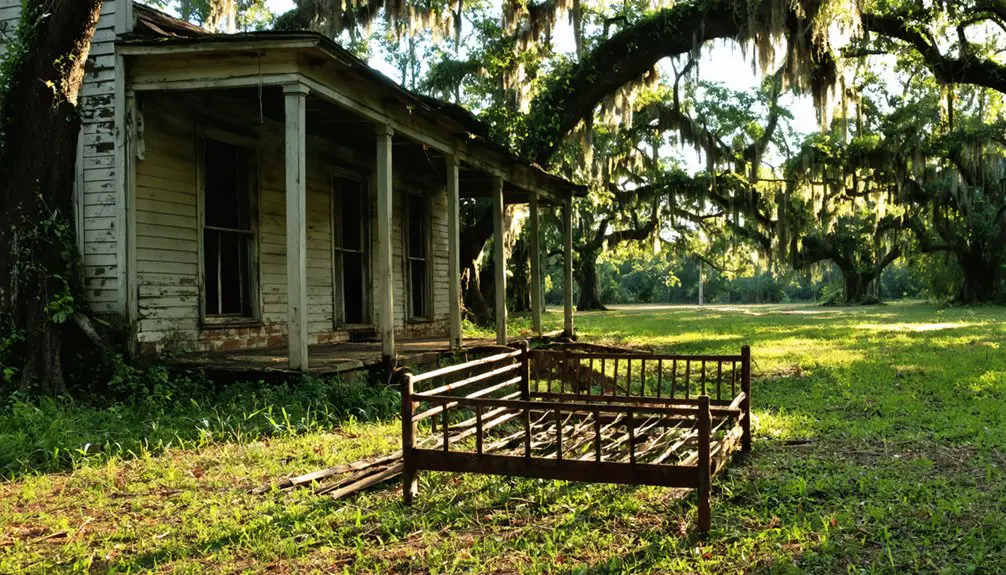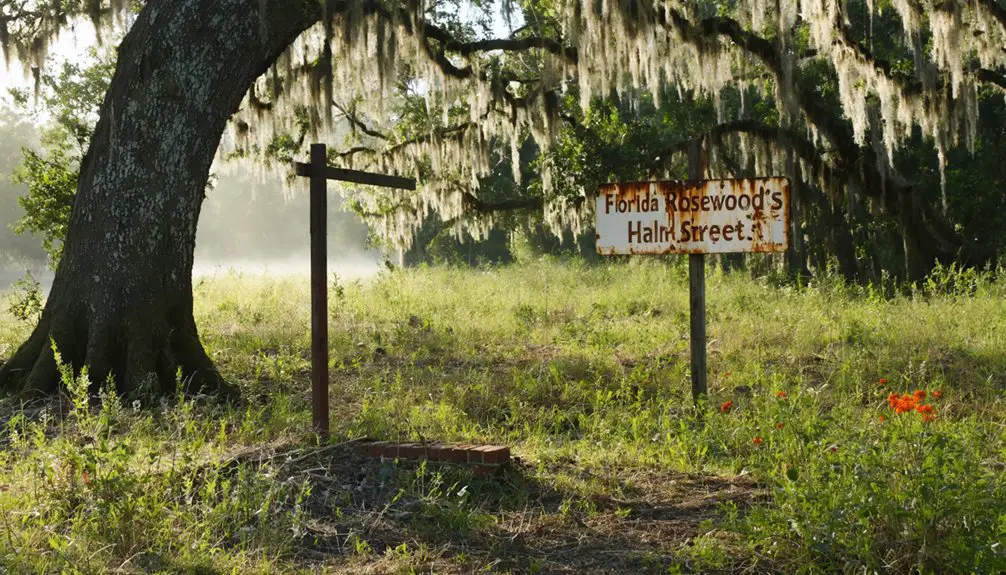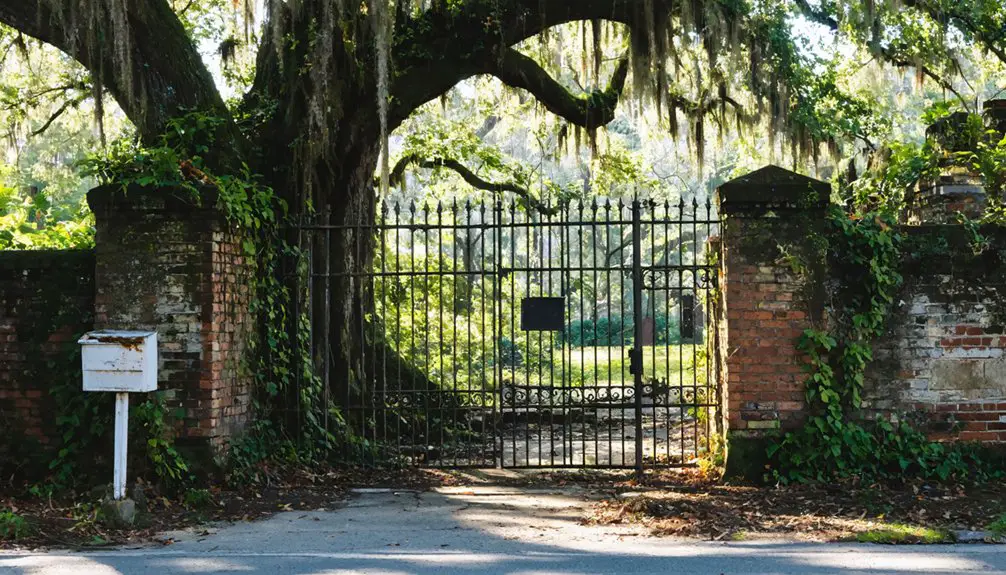You’ll find Rosewood’s haunting story in Levy County, Florida, where a thriving Black community of 355 residents once prospered through agriculture and local trades. In January 1923, a false assault accusation sparked devastating mob violence, leading white vigilantes to burn the town and kill at least eight people. After decades of enforced silence, Florida finally acknowledged the massacre in the 1990s, offering $2 million in reparations. The town’s untold stories still echo through its abandoned streets.
Key Takeaways
- Rosewood was a prosperous Black community in Florida that became a ghost town after a racially-motivated massacre in 1923.
- All buildings except John Wright’s house were burned down during the attack, permanently displacing the entire Black population.
- The town’s destruction stemmed from a false accusation of assault, leading to mob violence that killed at least eight people.
- Today, only a historical marker stands where the thriving community of 355 residents once existed.
- The abandoned town site represents one of America’s most tragic examples of racial violence destroying an entire community.
The Rise of a Thriving Black Community
When the Seaboard Air Line Railway established a whistle stop in rural Levy County, Florida, it sparked the creation of Rosewood – a mainly Black community that would flourish through agricultural enterprise and local trades.
You’ll find that Rosewood’s community growth stemmed from its residents’ determined pursuit of economic independence. They built their wealth through citrus cultivation, timber harvesting, and livestock raising, while establishing essential institutions like the Rosewood Baptist Church and local schools.
This cultural resilience manifested in a network of Black-owned businesses and social spaces that served the community’s needs. The town reached its peak of 355 residents in 1915, marking a period of significant growth and prosperity. Despite the pervasive racial discrimination of the Jim Crow era, Rosewood’s inhabitants created a self-sufficient haven where Black families could thrive.
Despite systemic racism, Rosewood’s Black community built a thriving network of businesses and gathering spaces that sustained their independence.
They fostered strong social bonds through church activities, educational initiatives, and shared cultural traditions, demonstrating remarkable autonomy in early 20th century Florida. Tragically, this prosperity ended in January 1923 when a white mob destroyed the entire community, forcing survivors to flee their homes and abandon their hard-earned property.
A False Accusation Ignites Racial Violence
You’ll find the origins of Rosewood’s destruction in Carrie Hunter’s unsubstantiated accusation on January 1, 1923, when she claimed a Black man had assaulted her in nearby Sumner.
This false charge sparked an immediate response from white vigilantes who formed armed posses to hunt for the alleged attacker in Rosewood’s Black community.
The news reached a Ku Klux Klan parade in Gainesville, where Klansmen began interrogating local residents about the incident.
As hundreds of white men descended upon the town, their violent search quickly escalated into deadly confrontations between the mob and Rosewood residents who tried to defend their homes.
Before its destruction, Rosewood was a thriving community that supported three churches and lodges.
A Woman’s Disputed Claim
The spark that ignited the Rosewood massacre came from Frances “Fannie” Taylor, a 22-year-old white woman who claimed a Black man had assaulted her in her Sumner, Florida home on January 1, 1923.
Her disputed narrative emerged right after a Ku Klux Klan parade in nearby Gainesville, intensifying the already tense racial dynamics of the Jim Crow South.
While Taylor initially reported physical assault and robbery, rumors quickly escalated to rape allegations, though no evidence supported these claims. The resulting violence led to several Black residents’ deaths and permanently displaced the community.
- Many Black residents believed Taylor fabricated the story to cover up an encounter with her white boyfriend.
- The accusation followed a common pattern used to justify racial violence in the South.
- No formal investigation ever validated Taylor’s claims against any Black man.
The consequences of her allegation would prove devastating for Rosewood’s Black community, leading to widespread terror and destruction that resulted in all but one building being burned to the ground.
Mob Violence Takes Hold
Following Frances Taylor’s disputed assault claim, an enraged white mob rapidly mobilized in Sumner and surrounding areas, releasing a wave of racial terror against Rosewood’s Black community.
The mob mentality quickly shifted from searching for an alleged attacker to orchestrating widespread community destruction. Hundreds of white men descended on Rosewood, leading to armed confrontations where both sides suffered casualties.
As violence escalated over several days in January 1923, Black residents defended their homes in fierce firefights that left at least five Black residents and two white attackers dead.
While some local whites, including merchant John Wright and Sheriff Bob Walker, helped protect and evacuate Black residents, most law enforcement either participated in or ignored the violence.
Many Black families sought refuge in surrounding swamps as the mob systematically destroyed their community. The violence resulted in virtually every building burned to the ground, leaving nothing of the once-thriving town.
Deadly Search Begins
On January 1, 1923, a white woman named Frances Taylor in Sumner, Florida, made an unsubstantiated assault claim against an unidentified Black man, igniting a deadly chain of events that would devastate the nearby town of Rosewood.
The accusation mobilized armed white posses who stormed into Rosewood, a reflection of the community’s historical trauma. You’ll find that this false claim mirrored countless other incidents across the Jim Crow South where accusations against Black men served as pretexts for racial violence.
Despite community resilience, the search quickly turned violent when Rosewood’s residents defended themselves, resulting in casualties on both sides.
- White mobs tortured and killed Black residents during interrogations
- Survivors fled into surrounding swamps to escape the violence
- Several sympathetic whites, including John M. Wright, provided shelter to fleeing residents
The Week That Changed Everything
During the first week of January 1923, Rosewood’s peaceful existence shattered after a white woman in nearby Sumner falsely accused a Black man of assault. The accusation sparked a devastating chain of events as a white mob, initially about 200 strong, descended upon the largely Black community.
A false accusation by a white woman unleashed deadly racial violence as an angry mob terrorized Rosewood’s Black residents in 1923.
The town had been home to nearly 200 African Americans who made their living through local industries and railroad work. You’ll find that despite remarkable displays of community resilience, Rosewood’s residents faced overwhelming violence. The mob systematically destroyed the town, burning every building except John Wright’s home. A subsequent grand jury investigation yielded no indictments or justice for the victims.
In a display of racial solidarity, Wright sheltered Black families while train conductors John and William Bryce helped transport women and children to safety. Many fled into the surrounding swamps, while others escaped to Gainesville.
At least eight people died in the violence – six Black residents and two white men – though the true death toll remains uncertain.
Fleeing for Survival: Stories of Escape

The desperate escape from Rosewood began as survivors fled into the dense swamplands surrounding their once-peaceful community. With no official protection, residents developed survival tactics that meant hiding in the marshes for days, enduring harsh conditions while white mobs searched the area.
Local Black leaders coordinated secret escape routes, evacuating survivors by train and automobile to safer cities like Gainesville. Much like the highly valued timber, the lives of Rosewood’s residents were precious yet under threat of destruction.
- Families hid beneath homes and in woods, running under gunfire while defenders fought back against attackers.
- The elderly, children, and infirm faced the greatest risks during evacuation due to limited mobility.
- Those who escaped became permanent refugees, losing their homes and possessions as buildings were systematically burned.
The traumatic exodus scattered Rosewood’s residents across Florida, many never to return, carrying psychological scars that would impact generations.
Decades of Silence and Hidden Truth
For decades after the 1923 massacre, you’ll find that Rosewood’s tragic history remained buried in collective silence as survivors and their families suppressed painful memories out of fear and trauma.
You won’t see much written documentation from 1923 until the 1980s, when media investigations finally began exposing the long-hidden truth about what really happened in the Florida town.
Through newspaper reports and survivor interviews in the early 1980s, you’ll discover how journalists helped uncover compelling evidence that challenged the original sanitized narrative of a “race riot” and revealed the organized nature of the racist violence.
Suppressing Painful Historical Memories
After surviving the horrific 1923 massacre, Rosewood’s displaced residents endured decades of enforced silence about the tragedy, with fear of retaliation and societal pressure keeping most survivors from sharing their stories publicly.
The historical trauma spread across generations as local governments and institutions refused to acknowledge or investigate the violence.
You’ll find that this collective amnesia wasn’t accidental – it resulted from systematic efforts to suppress the truth through media misrepresentation, educational omission, and official denial.
- White residents actively downplayed or denied the massacre’s severity, while authorities took no legal action against known perpetrators.
- Local schools excluded Rosewood from their curricula, effectively erasing it from public consciousness.
- Survivors’ families often discovered their own connection to Rosewood only through careful research decades later.
Media Uncovers Buried Past
While Rosewood’s tragic history remained buried for nearly six decades, investigative journalists in the 1980s began uncovering the long-suppressed truth about the 1923 massacre.
Media coverage exposed how a false assault accusation against a Black man led to the complete destruction of this prosperous African American community by a white mob.
Through historical investigation, researchers have employed modern technology like ground-penetrating radar and drones to locate physical evidence of the town.
Their work has revealed broader ethnic histories of Levy County while documenting survivor testimonies that had been passed down orally through generations.
Despite challenges from minimal formal records and early newspaper bias labeling it a “race riot,” media attention has helped preserve first-person accounts, validate archaeological findings, and push for official recognition of this act of racial terrorism.
Justice Delayed: Recognition and Reparations

Despite the horrific events of January 1923, justice for Rosewood’s victims remained elusive for over seven decades. The grand jury’s lost records and official silence perpetuated a culture of historical amnesia, leaving survivors and their families to bear their trauma alone.
It wasn’t until the 1990s that reparative justice began taking shape, culminating in Florida’s groundbreaking 1994 decision to award $2 million in reparations to surviving family members.
- The state’s acknowledgment marked the first time any U.S. state granted reparations for a racial massacre
- Historical memory was preserved through survivor testimonies and state-funded investigations
- Educational scholarships established in 2010 continue supporting descendants’ advancement
The 2004 memorial plaque and centennial commemorations in 2023 further cemented Rosewood’s place in America’s historical consciousness, though the journey to full justice remains ongoing.
Frequently Asked Questions
What Happened to the White Woman Who Made the False Accusation?
Quick as lightning, you’d find Fannie Taylor faced no consequences for her false accusations, though they sparked deadly racial tensions. She simply continued living while her lies destroyed Rosewood’s Black community.
Are There Any Remaining Physical Artifacts From Original Rosewood Buildings?
You’ll find very few Rosewood artifacts today – John Wright’s house stands as the only surviving original structure, accompanied by a historical preservation marker installed in 2004 to commemorate the massacre.
How Many Descendants of Rosewood Survivors Are Alive Today?
While nine survivors received reparations in 1994, you’ll find descendant stories are widespread today, though exact numbers aren’t documented. Survivor legacies continue through multiple generations attending reunions and preserving their history.
Did Any White Residents Help Protect Their Black Neighbors During the Massacre?
Yes, some white allies protected Black neighbors during the massacre. Notable examples include John Wright, a white businessman who sheltered Black residents, while a few other community members provided limited sanctuary amid the violence.
What Happened to the Land Where Rosewood Once Stood?
You’ll find the land largely abandoned, never restored to original residents. Today, it’s mostly reclaimed by nature, marked only by a historical significance plaque, with no meaningful land restoration efforts undertaken.
References
- https://www.aaihs.org/rosewood-massacre-at-100-black-florida-history-and-white-terror/
- https://stars.library.ucf.edu/cgi/viewcontent.cgi?article=4173&context=fhq
- https://www.splcenter.org/resources/stories/rosewood-centennial-racist-massacre-destroyed-black-florida-town/
- https://en.wikipedia.org/wiki/Rosewood
- https://news.tampaairport.com/family-memories-of-the-rosewood-massacre-live-on-through-special-tpa-art-exhibit/
- https://en.wikipedia.org/wiki/Rosewood_massacre
- https://dos.fl.gov/library-archives/research/explore-our-resources/florida-history-culture-and-heritage/rosewood/
- https://www.searchablemuseum.com/massacres-in-tulsa-rosewood-and-detroit/
- https://www.hklaw.com/-/media/files/events/2023/02/lessonsofrosewood.pdf
- https://digitalcommons.unf.edu/historical_architecture_main/4728/



